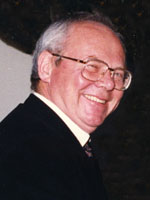
Ettore Bergamini
University of Pisa
Getting Better with Age
My first experience with the Gordon Research Conferences was in New Hampshire during the summer of 1970. I was close to the end of my postdoctoral training in molecular biology in Bernard Horecker’s laboratory at the Albert Einstein College of Medicine, and I was ready to go back to Siena, Italy, to work on the mechanism of male hormone action on muscle metabolism. Attending the Hormone Action Gordon Conference had been exciting and unforgettable. Besides its scientific benefit, this event made me realize how useful Gordon Conferences are to newcomers by helping them get to, and stay at, the frontiers of science. In 1988, a year after I had shifted my scientific specialty to biogerontology, I recalled these benefits and decided to attend the Biology of Aging Conference in Ventura, California, as well as almost every one of its subsequent meetings.
I used the GRC format model when I helped organize a binational Italy-U.S. conference called Protein Metabolism in Aging, held in April 1989 in San Miniato (Pisa), Italy. Harold Segal and Morton Rothstein, of the State University of New York, Buffalo, and Piero Ipata, of the University of Pisa, were co-organizers. The conference was a success: it was likened to a Gordon Conference and was the right event at the right time.
James Florini, a biogerontologist and a GRC trustee, was a member of the American delegation at the binational meeting, and he thought San Miniato would be an inexpensive, appropriate site for a small- to medium-sized Gordon Conference. He proposed the idea to Alexander Cruickshank, then the director of GRC. A few weeks later Robert Grasselli, who was traveling through Europe searching for good GRC sites, paid me a visit in Pisa and toured the San Miniato site. An additional Italian site was also chosen–Volterra, a small, beautiful city nearby, rich in Etruscan and medieval monuments. A GRC delegation led by Cruickshank and Florini soon came and approved both sites. In September 1990 two successful Gordon Conferences were held in Volterra, and then two more in 1991 in San Miniato, one of which was Biology of Aging, chaired by Arlan Richardson. Substantial financial support had been obtained from local banks (Cassa di Risparmio di Volterra and Cassa di Risparmio di San Miniato), the Italian National Research Council, and the Serono Foundation, which made the conferences in Italy as inexpensive and convenient as those in New Hampshire and California.
A committee for GRC European activities was established, with Robert Grasselli as chair and myself as the European vice chair. This was an unforgettable experience. I was able to serve GRC by providing guidance on local resources essential to the conferences in Italy. Other Gordon Conferences hosting hundreds of renowned sci-entists of many nationalities have since met in Italy; Il Ciocco, which is close to Pisa, is now a major GRC site in Europe. Italian science, especially biogerontology re-search and education, has benefited significantly from this: in the 1990s three Biology of Aging Gordon Conferences were run in Tuscany, and several international organizations as well as a European Union-sponsored summer school on biogerontology were started.
In the past decade the growing interest in the mechanisms of cell maintenance (including apoptosis and more recently autophagy) has been noticed by the GRC directors and board. This has been of crucial importance for the field of aging and age-associated diseases. In the last ten years new Gordon Conferences provided a forum for rapid advances in research in molecular and cellular biology of programmed cell death as well as cell organelle degradation and renewal. These were big steps forward to a modern understanding of aging, anti-aging intervention, and age-associated diseases, including neurodegeneration, atherosclerosis, and cancer.